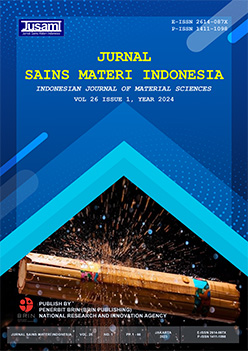Energy Analysis and Economy Performance of a Hybrid Solar Dryer for Drying Coffee
DOI:
https://doi.org/10.55981/jsmi.2024.3135Keywords:
Coffee, Drying rate and efficiency, Economic analysis, Hybrid solar dryer, Total fat and protein contentAbstract
This work studies the effect of the drying temperature on the profile of the water content, drying rate, drying efficiency, economic performance, and the quality of Robusta and Arabica coffee beans using the hybrid solar dryer. The drying instrument with the help of LPG heating is used in this research with a specified temperature of 40 ℃, 50 ℃, and 60 ℃. The research is conducted on a sunny day for 1 day for each temperature and coffee beans. The temperature profile shows that the lowest water content in the study is 60 ℃. The drying rate for both 50 ℃ and 60 ℃ are similar and the highest average efficiency of the instrument is at 50 ℃ for both Robusta and Arabica beans. The dominant peak in GCMS analysis result of coffee samples was caffeine with a total area percentage of 30.89%, the description of the coffee bean structure using SEM test resulted in a hole size of 5-10 µm, the obtained fat content was 1.6%, the obtained protein content 17.3%. A hybrid solar dryer is an environmentally friendly solution that enables faster coffee drying, with a payback period of 1.5 years for both coffee bean types.
Downloads
References
S. Najiyati and D. Danarti, “Kopi Budi Daya dan Penanganan Pasca Panen,” Penebar swadya. Jakarta, 2004.
D. W. Kurniawan and T. N. S. Sulaiman, “Teknologi Sediaan Farmasi,” Yogjakarta: Graha Ilmu, 2009.
N. Asni and A. Meilin, Teknologi Penanganan Pascapanen Dan Pengolahan Hasil Kopi Liberika Tungkal Komposit (Libtukom). 2015.
L. P. Mahardhika, S. P. Lestari, and Y. Bow, “Rancang bangun alat pengering tipe tray dengan media udara panas ditinjau dari lama waktu pengeringan terhadap exergi pada alat heat exchanger,” KINETIKA, vol. 7, no. 1, 2016.
Ratnasari, “Pengaruh suhu dan lama perendaman terhadap laju pengeringan kacang hijau pada kinerja alat rotary dryer,” Ratnasari, vol. 1, no. 2504, 2014.
M. Fauzi, Y. Witono, and A. Pradita, “Karakteristik Organoleptik hasil Blending Dari Berbagai tingkat Sangrai Kopi Luwak In Vitro,” Prosiding Seminar Nasional Inovasi Teknologi Untuk Masyarakat, 2016.
S. Dhanushkodi, V. H. Wilson, and K. Sudhakar, “Design and performance evaluation of biomass dryer for cashewnut processing,” Pelagia Research Library Advances in Applied Science Research, vol. 6, no. 8, 2015.
L. Sri, R. M. N., Tamrin, Warji, Budianto, “Uji Kinerja Alat Pengering Tipe Batch Skala Lab Untuk Pengeringan gabah Dengan Menggunakan Bahan Bakar Sekam Padi,” Jurnal Teknik Pertanian Lampung, vol. 2, no. 3, 2013.
S. Otles and V. H. Ozyurt, “Sampling and Sample Preparation,” in Handbook of Food Chemistry, 2015. doi: 10.1007/978-3-642-36605-5_39.
W. Dong, R. Hu, Z. Chu, J. Zhao, and L. Tan, “Effect of different drying techniques on bioactive components, fatty acid composition, and volatile profile of robusta coffee beans,” Food Chem, vol. 234, 2017, doi: 10.1016/j.foodchem.2017.04.156.
AOAC, “AOAC. (1995). Official methods of analysis 16th Ed. Association of official analytical chemists. Washington DC, USA.,” Association of Official Analytical Chemists.
J. Hipple, Chemical engineering for non-chemical engineers. 2017. doi: 10.1002/9781119369196.
R. E. Treybal, Mass Transfer Operations 3th edition. 1981.
F. G. Winarno, “Kimia Pangan dan Gizi. Gramedia pustaka utama,” Jakarta. Liberty. Yogyakarta, vol. 13, no. 2, 2004.
R. J. Clarke and O. G. Vitzthum, Coffee: Recent Developments. 2008. doi: 10.1002/9780470690499.
O. Gonzalez-Rios et al., “Impact of ‘ecological’ post-harvest processing on the volatile fraction of coffee beans: I. Green coffee,” Journal of Food Composition and Analysis, vol. 20, no. 3–4, 2007, doi: 10.1016/j.jfca.2006.07.009.
S. Oestreich-Janzen, “Chemistry of coffee,” in Comprehensive Natural Products II: Chemistry and Biology, vol. 3, 2010. doi: 10.1016/b978-008045382-8.00708-5.
Z. Liu, Y. Guo, Z. Zhang, and X. Zhu, “Soft control of scanning probe microscope with high flexibility,” Scanning, vol. 29, no. 3, 2007, doi: 10.1002/sca.20054.
D. K. Verma and P. P. Srivastav, “Proximate Composition, Mineral Content and Fatty Acids Analyses of Aromatic and Non-Aromatic Indian Rice,” Rice Sci, vol. 24, no. 1, 2017, doi: 10.1016/j.rsci.2016.05.005.
E. B. Tarigan and J. Towaha, “Effects of Fruit Maturity, Bean Fermentation and Roasting Time on Physico-Chemical Characters of Robusta Coffee,” Jurnal Tanaman Industri dan Penyegar, vol. 4, no. 3, 2017, doi: 10.21082/jtidp.v4n3.2017.p163-170.
Downloads
Published
How to Cite
Issue
Section
License
Copyright (c) 2024 Suherman Suherman, Hadiyanto Hadiyanto, Nicholas Franz, Vimala Kamandjaja, Tubagus Rayyan Fitra Sinuhaji

This work is licensed under a Creative Commons Attribution-ShareAlike 4.0 International License.








